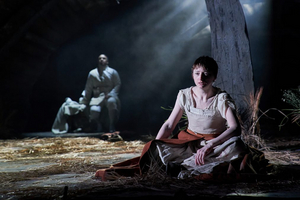Review: FAUSTUS: THAT DAMNED WOMAN, Lyric Hammersmith

![]() If, like many, you find yourself wishing you could change the world right now, you might want to first pop down to the Lyric Hammersmith to see Chris Bush's Faustus: That Damned Woman. Taking Christopher Marlowe's Renaissance play and bringing parts of it into the 21st century, Bush's new work reminds audiences that dealings with the Devil always ever benefit one person. Hint: it's not you or me.
If, like many, you find yourself wishing you could change the world right now, you might want to first pop down to the Lyric Hammersmith to see Chris Bush's Faustus: That Damned Woman. Taking Christopher Marlowe's Renaissance play and bringing parts of it into the 21st century, Bush's new work reminds audiences that dealings with the Devil always ever benefit one person. Hint: it's not you or me.
This is an adaptation, of sorts. The play roughly follows Marlowe's original narrative: Faustus makes a deal with Lucifer, is given Mephistopheles as an aide, and the two travel around using unimaginable powers. The agreement? An extra-long life (144 years, to be exact), the ability to time-travel (though only forwards) and magical powers in exchange for signing one's life and soul to the Devil.
But where Marlowe's Faustus flaunts and wastes his abilities, Bush's Johanna Faustus (Jodie McNee) is determined to use her powers for good. She hopes to cure the plague blighting London and, as she travels through time, tackles the illnesses that threaten each generation. Her goal, ultimately, is to create a world without death so that its people are beholden to neither God nor the Devil.
Where Act One broadly remains consistent with Marlowe's work, the roving Act Two jumps quickly. Moving from the Renaissance to the Victorian period to the early 20th century and then beyond, the play loses some focus. Yet, at two hours, the play is also overlong, and consequently director Caroline Byrne and Bush haven't quite managed to fully display this new Faustus's power.
An unsettling supernatural focus is captured in the opening scenes, which display the trial of Johanna's mother, who is thought to be a witch. Johanna watches these past events with the aid of two local women, who hold her down in a bucket of water as she sees these visions of the past. They are enveloped in Ana Inés Jabares-Pita's large rib-cage set, which provides an imposing sense of bodily degeneration.
Giles Thomas's sound design leaves an uncomfortable resonance lingering throughout the play, and Richard Howell's lighting is atmospheric and unstable - the Devil could indeed be hiding anywhere in the dark recesses of the stage.
The gender switch broadly works well and leads to points of humour: Faustus toyingly suggests she already has a man when someone talks to her of marriage, for example. McNee is an earnest, insomniac Faustus, with a wide-eyed energy that roves from fidgeting uncertainty to strutting confidence.
The mixed performances elsewhere however suggest a slight dissonance between the rehearsal room and the stage. Danny Lee Wynter's fun Mephistopheles sadly remains one-note, while Emmanuella Cole does well to juggle her numerous roles.
More may well have been made about the historical contexts that inform the play, from Renaissance witch trials to Victorian attitudes towards mental instability and Bedlam, or the uncanny overtones inspired by the set. The play's beguiling ending would also achieve more if it was more efficiently set up throughout the rest of the show.
Faustus: That Damned Woman therefore proves a zealous piece that confirms Bush as one of British theatre's most exciting, provocative writers. Bush tackles one of literature's most familiar stories, and, though not completely successful, her adaptation does well to present an alternative telling that, like Faustus herself, has so much potential.
Photograph credit: Manuel Harlan.
Videos
